Last updated on October 18, 2022
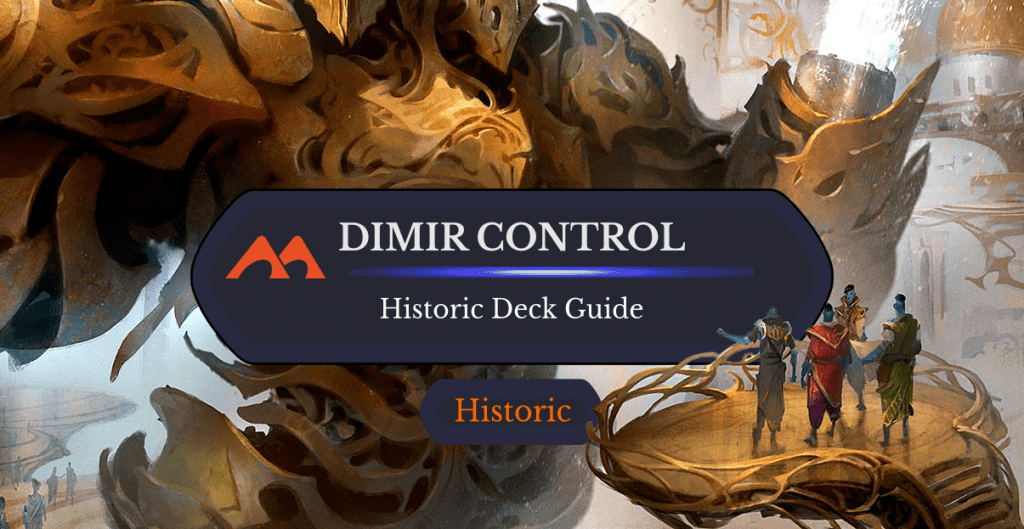
Torrential Gearhulk | Illustration by Svetlin Velinov
With the most recent ban announcement, WotC has shaken up the Historic meta yet again. Brainstorm has been suspended, which is quite the blow since it was used in almost every blue deck in the format.
This means that Izzet Mastery Combo, Jeskai Control, and Izzet Phoenix were heavily impacted to the point that they’ll struggle to adapt. However, there’s one blue deck that didn’t care about this ban too much: Dimir Control.
This archetype has consistently put up good results, even before Brainstorm’s introduction in the meta. That previous build was mainly piloted by none-other than the control master, Andrew Cuneo.
Let’s find out why Dimir Control is one of the most solid archetypes for Historic’s current meta!
The Deck

Narset, Parter of Veils | Illustration by Magali Villeneuve
Planeswalker (4)
Creature (3)
Instant (19)
Cling to Dust
Fatal Push x3
Censor x4
Negate
Eliminate
Saw It Coming x2
Behold the Multiverse x2
Hieroglyphic Illumination
Vraska's Contempt
Sublime Epiphany
Commit // Memory x2
Sorcery (3)
Enchantment (3)
Search for Azcanta
Shark Typhoon x2
Artifact (1)
Land (27)
Castle Locthwain
Castle Vantress
Drowned Catacomb x3
Fabled Passage x3
Fetid Pools x4
Field of Ruin x4
Island x4
Swamp x3
Watery Grave x4
Sideboard (15)
Thoughtseize x3
Languish x2
Shadows' Verdict
Thought Distortion
Fatal Push
Aether Gust x3
Test of Talents
Mystical Dispute
Sublime Epiphany
Leyline of the Void
This deck runs a solid control strategy that relies on removal, sweepers, and counters to dominate the game’s early stages. Torrential Gearhulk and Shark Typhoon are your main win conditions in the later game, quickly turning the board state around in your favor.
History of Dimir Control
The first time I ran into this deck was on Gabriel Nassif’s Twitch stream testing it for a League weekend early on in the Kaldheim meta. Unfortunately the deck wasn’t very popular yet. It was almost unplayable before that since ramp strategies running Omnath, Locus of Creation or Uro, Titan of Nature's Wrath made control strategies practically impossible to play.
Historic changed and allowed control strategies to rise again after those legendary creatures got banned. As I mentioned earlier, Andrew Cuneo is the player that had the most success with it.
Dimir Control has been rising in popularity in more recent events since it has multiple cards that do an excellent job at controlling the game. More importantly, it has the tools to adapt to whatever is happening in the moment.
This proved to be the case in the latest League weekend as almost everyone from the CFB team ran it with a positive win rate, despite the meta being dominated by Izzet Phoenix strategies.
The Strategy
Removal Package
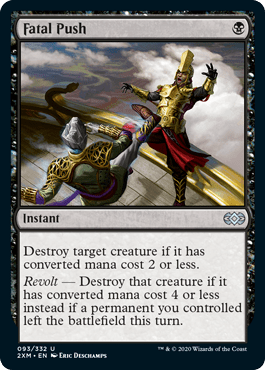
Fatal Push is the primary removal spell for the early stages of the game. It can deal with almost every aggro strategy and it pairs very well with Fabled Passage, Field of Ruin, and Mind Stone to kill larger creatures at later points in the game.


A single copy of Eliminate is nice to have as it can deal with planeswalkers like Narset, Parter of Veils. Vraska's Contempt is your last spot removal that works very well against aggro and control strategies. Getting some life back is great, as well as getting rid of annoying planeswalkers.
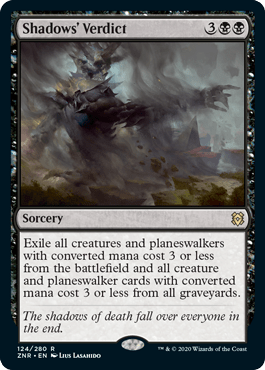
As for board wipes, you’ve got three copies of Shadows' Verdict that deal with almost every popular creature in aggro decks. Post-sideboard you have access to an extra copy plus two more board wipes in the form of Languish.
Counter Package
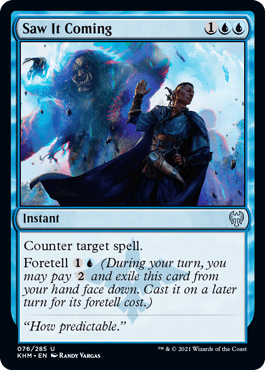
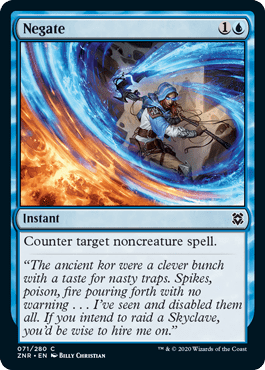
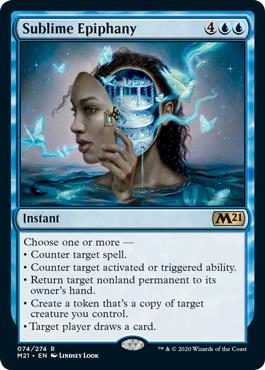
You’ve got Saw It Coming, Negate, and Sublime Epiphany to prevent dangerous spells from resolving. The first two are standard counterspells while the latter is also part of your primary win condition. The plan is to counter something and copy an already-resolved Torrential Gearhulk to cast another copy of Epiphany and repeat the process. If you already played Epiphany you can recast it from the graveyard with your Gearhulk and get the same effect, so don’t be afraid to play it when needed without a Gearhulk already in play.

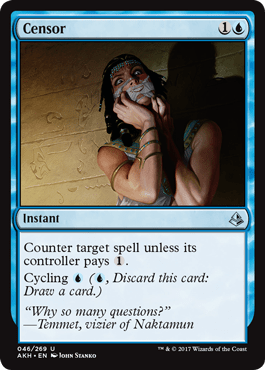
Commit // Memory also acts as a pseudo-counterspell that can be used as removal for any dangerous permanent on your opponent’s side of the field. Last but not least, Censor is a fine cycle card that can catch your opponent off-guard, but its main role is to thin your deck and reach your land drops faster. Still, not everyone plays around it and you’ll get a couple decent targets every once in a while.
Card Advantage Package
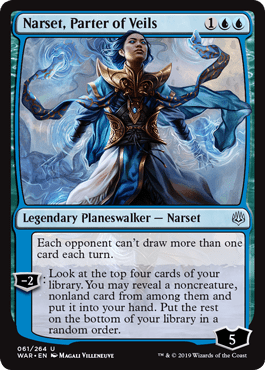
Narset, Parter of Veils provides tons of card advantage and taxes your opponent by not letting them draw more than one card per turn. This turns out to be very annoying for your opponent as they can’t cycle spells like Shark Typhoon or Censor on their main phase, keeping them from digging further into their deck. It also shuts down Teferi, Hero of Dominaria’s first ability, to some extent.

Those are undoubtedly cute synergies, but the main combo is to cast the sorcery side of Commit // Memory while Narset is in play to draw an entirely new hand while leaving your opponent with just one card. This interaction on an empty board is usually enough to close games.
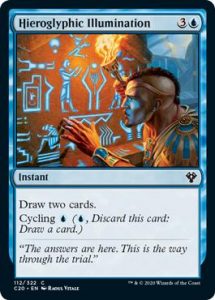
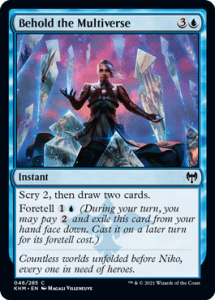

The rest of our card advantage package includes Hieroglyphic Illumination, Behold the Multiverse, and Search for Azcanta, which all help dig deeper into the deck.
Other Non-Creature Spells
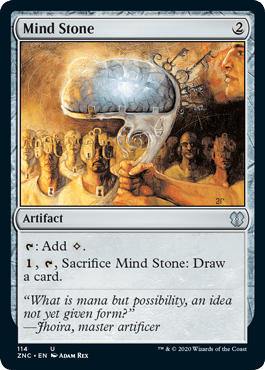
The remaining cards fill multiple roles. Mind Stone is there as a single copy to ramp into your board wipes quicker but can also be used to trigger Fatal Push or just draw a card in the late game.
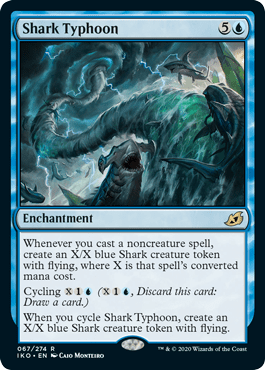
Shark Typhoon is one of our main win cons when hard cast but sometimes gets cycled to get a decent attacker against opposing control decks or as a blocker when needed. Most of the time you’re better off cycling the Typhoon even for zero since you want to consistently make land drops every turn.

Cling to Dust is the last non-creature card from the deck. It acts as graveyard hate and a card draw engine, especially against other control builds. It doesn’t perform very well against aggro, but it can get you a couple of life back in a rough spot.
The Creature: Torrential Gearhulk
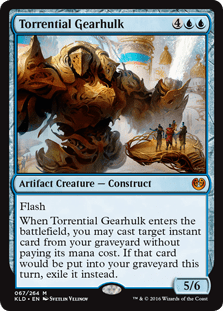
The only creature that this deck runs — and by far the best card in the deck. The ability to rebuy spells from the graveyard is huge, but it can multiply itself thanks to Sublime Epiphany to close games in two swings.
The key here is to run as many instant spells as possible to have more options available to answer threats accordingly. One resolved Gearhulk is usually enough to close games on its own but be aware that it’s fragile against artifact hate. Both Prismari Command and Kolaghan's Command are popular cards right now, so try to cast it with backup counterspells as much as you can.
The Lands
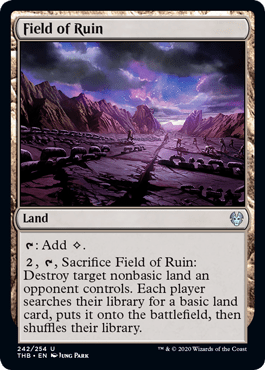

The deck runs a very solid mana base with tons of dual lands that fill the role of fixing your curve. Because of this you can run other lands like Field of Ruin that can deal with opposing manlands or utility lands even though they only produce colorless mana. Examples of those are Faceless Haven and the cycle of Castles from Throne of Eldraine.

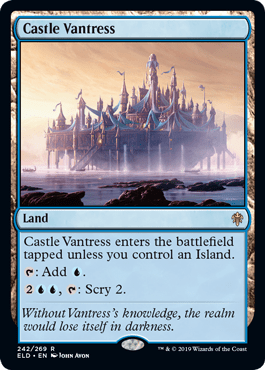
Speaking of Castles, we run a single copy of both Castle Locthwain and Castle Vantress, which helps the late game when looking for answers or in control matchups where nothing is getting played at the end of each turn.

Fabled Passage can fix your mana and help you trigger Fatal Push’s revolt ability. Just be careful to keep your basic land count in mind since you’re also fetching lands from your library with Field of Ruin. I’ve run into situations where no basic lands are left in the deck on more than one occasion.
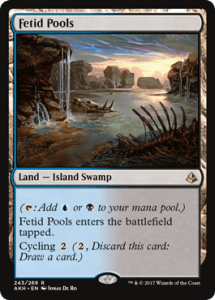
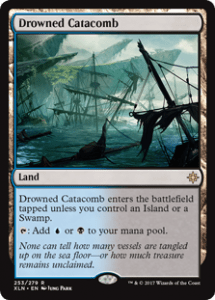
Finally, Fetid Pools helps your Castles and Drowned Catacombs enter the battlefield untapped, serving the same function as Watery Grave without paying the two life. The Pools can be cycled late game or when needed, though. Just don’t rush into cycling them too early as you don’t want to fail any land drop unless you’re looking for a specific answer from your deck.
Common Interactions

Behold the Multiverse | Illustration by Magali Villeneuve
Control decks are usually tough to maneuver, and some interactions are probably a bit more challenging to spot if you haven’t played with the deck before or haven’t seen it in action. But don’t worry, I’ve got you:
- Commit // Memory is a versatile spell. It doesn’t actually counter a spell on the stack, it just bounces it back into the library. This is very important against opposing spells that can’t be countered, like Shifting Ceratops or Commence the Endgame.
- Field of Ruin is great against cards like Faceless Haven, but it can also deal with greedy mana bases, especially in decks running three colors or more. There have been times where I noticed that some of my opponents playing Jund Sacrifice didn't run more than a couple of basics on their decks. So, in essence, Field of Ruin acts as a pseudo-Wasteland.
- After you’ve put your opponent’s spells back into their library with either Commit // Memory or Aether Gust, you can make them shuffle their library with a Field of Ruin activation if you don’t want to have them draw them again.
- I already explained the Narset, Parter of Veils–Commit // Memory combo and how it’s backbreaking. But it can be pushed to its maximum potential when we throw Torrential Gearhulk into the party. Since Commit is an instant, you can cast Memory as an instant as well. You can leave your opponent without any options at the end of their draw phase while you get a full hand on your turn.
- Both Behold the Multiverse’s and Saw It Coming’s foretell abilities can be played at instant speed on your turn. You can opt to put them into the foretell zone at the end of your turn on more than one occasion.
- Speaking of foretell, you can keep your opponent guessing whether or not you have Saw it coming by foretelling Behold the Multiverse. This may slow them down, of course, which is excellent for you.
- Against control builds, you often side out all of your spot removal and board wipes, but make sure to keep at least a couple of them if your opponent is running Shark Typhoon.
Sideboard Guide
Control and Combo Matchups

Thoughtseize is your main sideboard tool in control and combo matchups. Getting information about what they have is crucial for you as you can plan your next turns and plays according to what you see in their hand. Plus you get rid of their most threatening card. This card got indirectly buffed after Brainstorm’s ban since your opponent can’t hide their key cards in their libraries anymore.
Aggro and Tribal Board Wipe
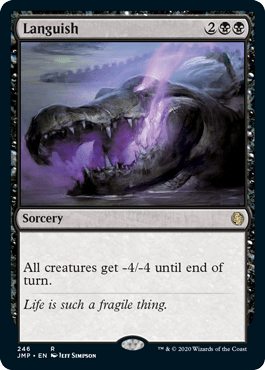
Languish is cheaper than Shadows' Verdict and it’s a great answer against the most popular aggro matchups like Selesnya Company and Gruul Aggro. It’s also very effective against tribal strategies like goblins or elves that threaten to put a short clock on you.
Anti-Counter Control
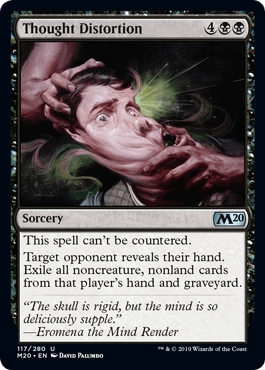
An excellent card against control matchups as Thought Distortion can’t be countered and can quickly turn the tables on control standoffs by having your opponent discard all of their cards.
Red and Green Matchups
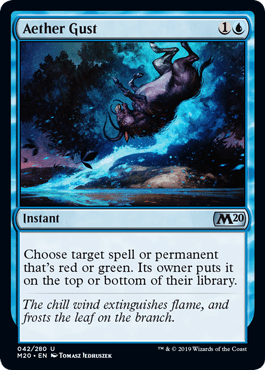
Aether Gust acts as a cheaper version of Commit // Memory that works very well against red or green decks. It’s also a great answer against cards like Klothys, God of Destiny and Shifting Ceratops.
Emergent Ultimatum Matchups

Test of Talents was previously an extra copy of Negate, but I expect that Emergent Ultimatum decks will rise in popularity soon and this card can deal with the whole strategy while countering just one of their spells.
Control, Tempo, and Azorius Auras Matchups
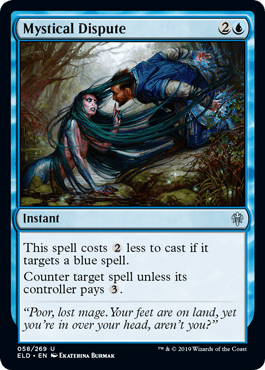
Mystical Dispute is great against control decks as well as tempo decks like rogues and even Azorius Auras builds.
Graveyard Hate
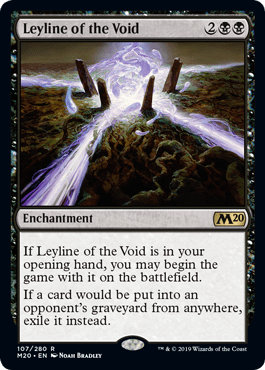
You want to run some sort of graveyard hate but other options like Grafdigger's Cage aren’t really viable because you don’t want to hurt yourself. Part of your main plan relies on reusing the graveyard after all. Leyline of the Void only punishes your opponent, and this makes it a fantastic option.
Other Cards to Try
As the meta changes, it’s always good to have some card options that you can swap back and forth between your builds. Here are just some of them.
Power Word Kill
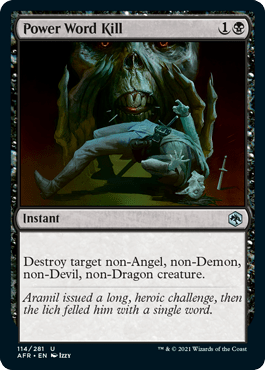
A powerful removal spell, almost unconditional. The problem is that Korvold, Fae-Cursed King is very popular at the moment. Otherwise, Power Word Kill can kill almost everything.
Hive of the Eye Tyrant
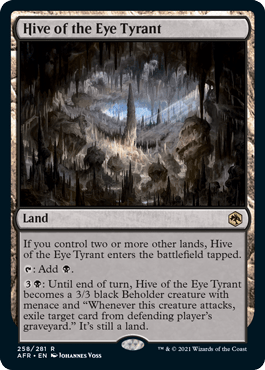
Remember how powerful Creeping Tar Pit was? Well, Hive of the Eye Tyrant is the closest we have to that. It’s not as powerful, but it can deal the final points of damage when needed, with the plus of exiling some cards from your opponent’s graveyard.
Memory Lapse
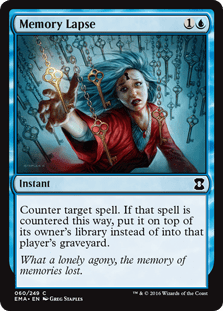
Some players like running Memory Lapse in their main deck, especially in Jeskai Control. I haven’t tested this one out, but it didn’t seem to perform well against Izzet Phoenix decks. Its usage may increase in the coming meta.
Doom Blade
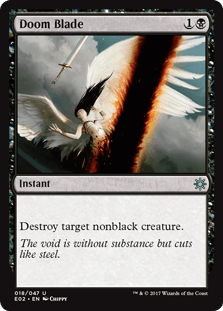
Doom Blade is an excellent removal spell that shares the same problem as Power Word Kill. It can also unfortunately be a dead card against mono black aggro decks if those get popular. Other than that, this card has been great.
Legion’s End
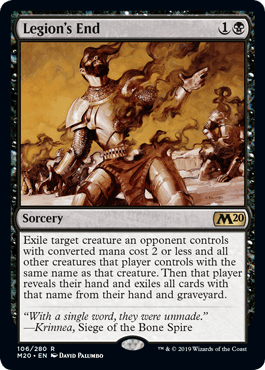
Legion's End is used primarily against combo decks like the previously mentioned Emergent Ultimatum, and it’s another option to beat them if they rise in popularity.
Commence the Endgame
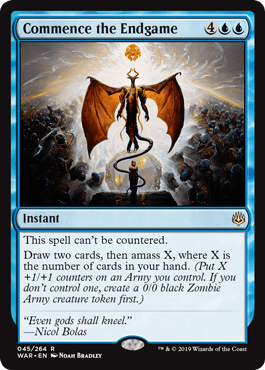
Commence the Endgame is very sweet in mirror matchups and against any blue control-based decks as it can’t be countered, provides you with card advantage, and gives a body that your opponent needs to interact with.
Baleful Mastery

A very similar card to Vraska's Contempt and Eat to Extinction. All of these fill the same role and can be swapped or added depending on your preference or specific threats to answer.
Cerulean Drake
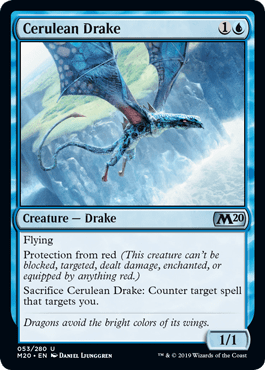
Finally, If Izzet Phoenix decks are still dominant even after the Brainstorm ban, Cerulean Drake is a great weapon against them. It brick walls two-thirds of that deck’s creatures and can’t be quickly removed from the battlefield.
Wrap Up
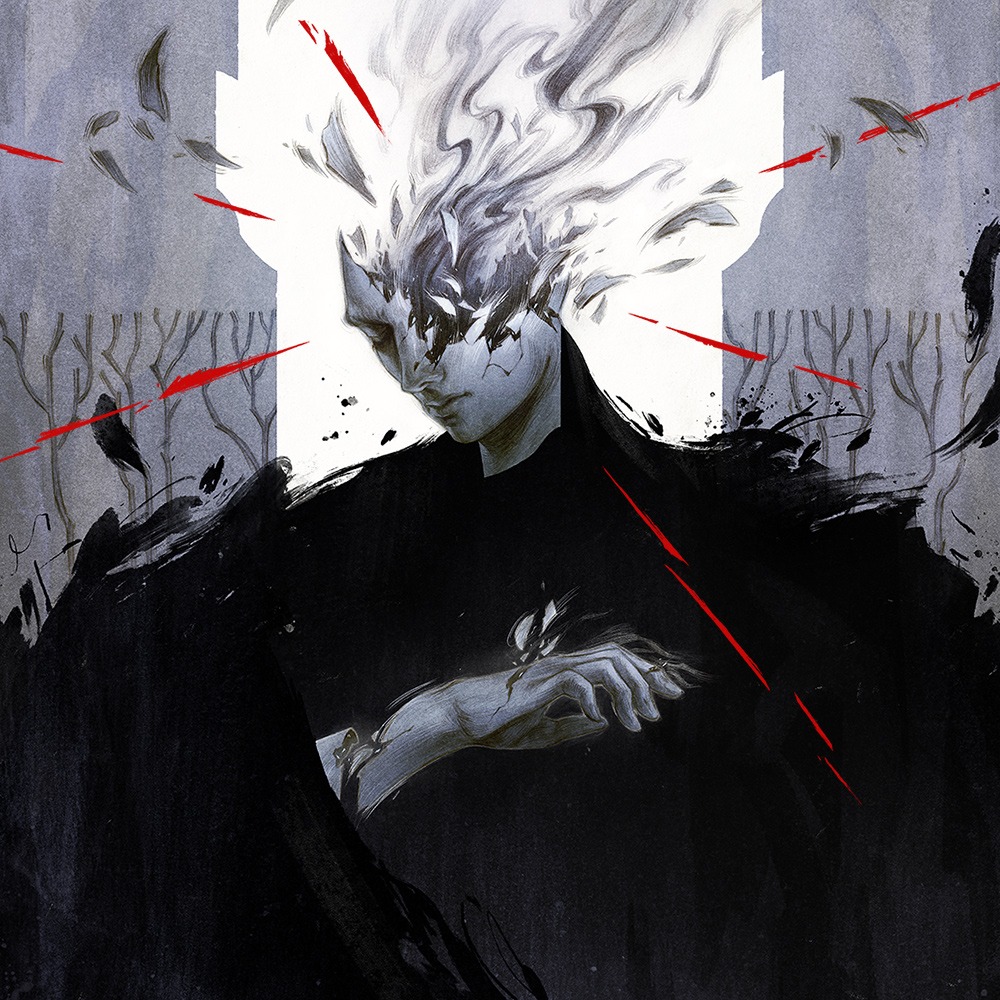
Eliminate (Strixhaven Mystical Archive) | Illustration by Rovina Cai
This has been an entertaining deck to play. It involves a lot of thinking and practice to get used to it. The more you play Dimir Control the more you’ll like it, and the better you’ll get at playing it.
It takes a lot of time and practice to dominate control decks, but once you master them, you can easily adapt to any meta. Try to get comfortable with a build you like and be patient and focused so you can get better at reading your opponent’s plays.
I hope you have as much fun as I did if you test this deck out. Don’t forget to let me know in the comments how it performed for you and which changes you’d make to improve it! And make sure to grab Arena Tutor if you’re playing on MTGA a lot and want a free app to track your matches.
As always, take care and have a good one!
Follow Draftsim for awesome articles and set updates: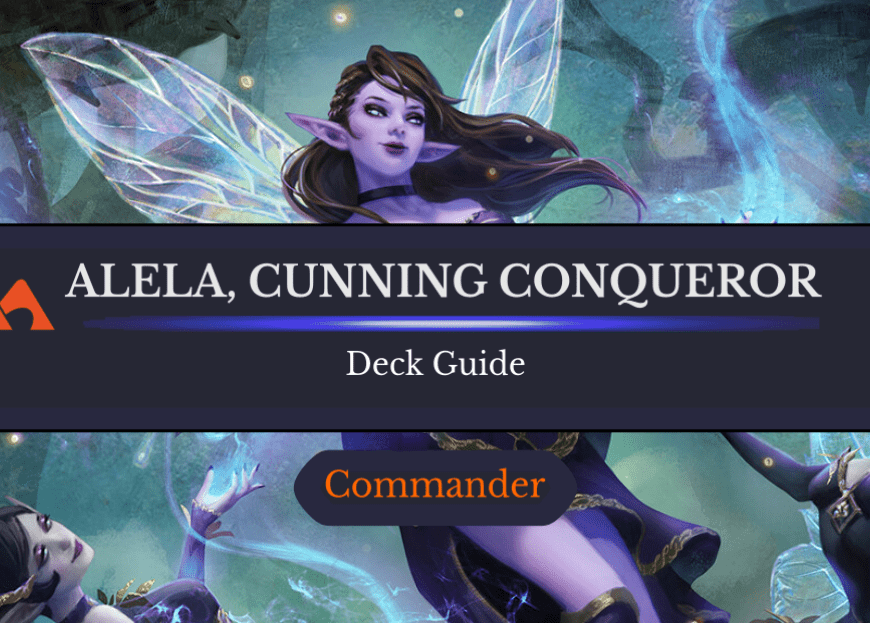
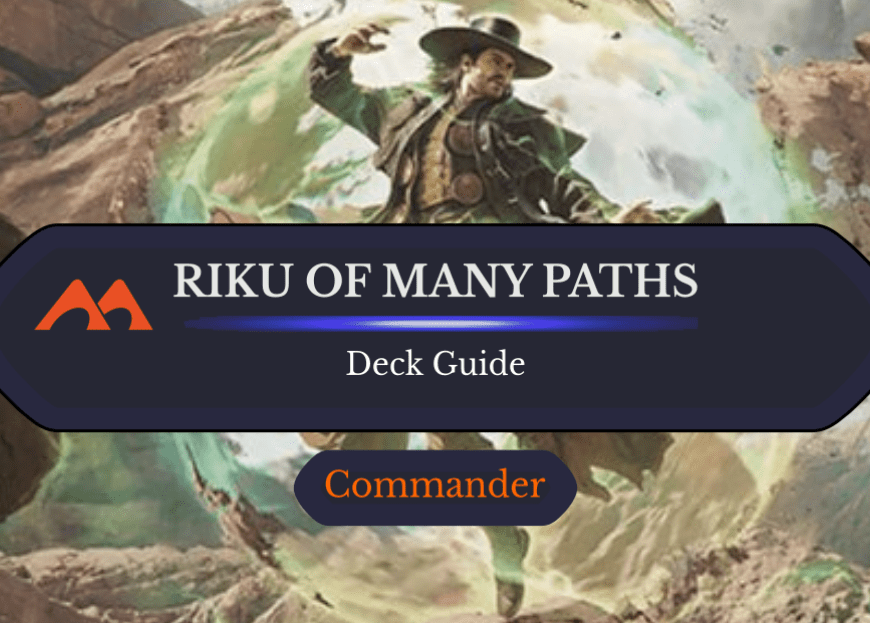
Add Comment